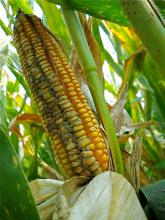Information Possibly Outdated
The information presented on this page was originally released on April 26, 2012. It may not be outdated, but please search our site for more current information. If you plan to quote or reference this information in a publication, please check with the Extension specialist or author before proceeding.
Corn researchers develop in-field aflatoxin approach
By Rebekah Ray
MSU Delta Research and Extension Center
STONEVILLE -- Scientists at Mississippi State University’s Delta Research and Extension Center are researching new ways to reduce aflatoxin in infected corn.
Corn is one of the state’s leading row crops, but it is susceptible to aflatoxin, a fungus that can reduce profits and hurt marketability.
MSU plant pathologist Gabe Sciumbato and U.S. Department of Agriculture’s Agricultural Research Service plant pathologists Hamed Abbas and Mark Weaver have obtained strains of the fungus that do not produce aflatoxin.
Sciumbato, a Mississippi Agricultural and Forestry Experiment Station scientist, has been conducting research on aflatoxin for more than 10 years. Aflatoxins are naturally occurring chemicals produced by the fungi Aspergillus flavus and A. parasiticus. The fungi appear as yellow-green or gray-green molds on corn in the field or in storage.
“We are applying granules of Aspergillus flavus that do not produce aflatoxin but do compete with the native Aspergillus flavus. In essence, we are using a good fungus to fight a bad one,” Sciumbato said.
Aflatoxin levels are not normally high in corn, but Mississippi’s hot, humid climate encourages the growth of the fungus that produces the toxin. Heat, drought, high humidity, insect infestation and anything else that stresses the crop favor fungal growth, he said.
Aflatoxin can build up in crops such as corn, cotton, peanuts and tree nuts. Aspergillus infects corn by invading through corn silks or through insect damage to kernels or ears.
To date, methods of reducing aflatoxin infection have included crop management techniques, such as planting early, irrigating, avoiding infected areas and sanitizing equipment. Despite these techniques, grains of many Mississippi farmers have been rejected at elevators because of high levels of aflatoxin.
Onsite screening is done two ways. Blacklight or ultraviolet light tests and commercial test kits indicate aflatoxin presence. Commercial test kits use chemical analyses to test for specific proteins.
The USDA has set rejection levels for aflatoxin in corn at 20 parts per billion or greater. An individual kernel of corn can contain 400,000 ppb aflatoxin, so one infected kernel in 20,000 could lead to the shipment being rejected. Contaminated corn is sold at much lower prices.
Some rejected corn is used in livestock feed, which the Food and Drug Administration still screens. Corn containing aflatoxin also can be used to make ethanol or to make anhydrous ammonia for agricultural use. However, the aflatoxin is a toxic waste, and its disposal is expensive.
“Because corn is used in so many products for human consumption, we have been working to increase producer profits while maintaining food safety,” Abbas said.
Government guidelines keep aflatoxin contamination a low-level threat for food supplies in the country.
Using non-aflatoxin-producing A. flavus strains has the potential to protect much of the state’s corn harvest, Sciumbato said.
In 2011 corn ranked fifth in agricultural production in Mississippi. Last year the state’s farmers planted about 810,000 acres in corn.




